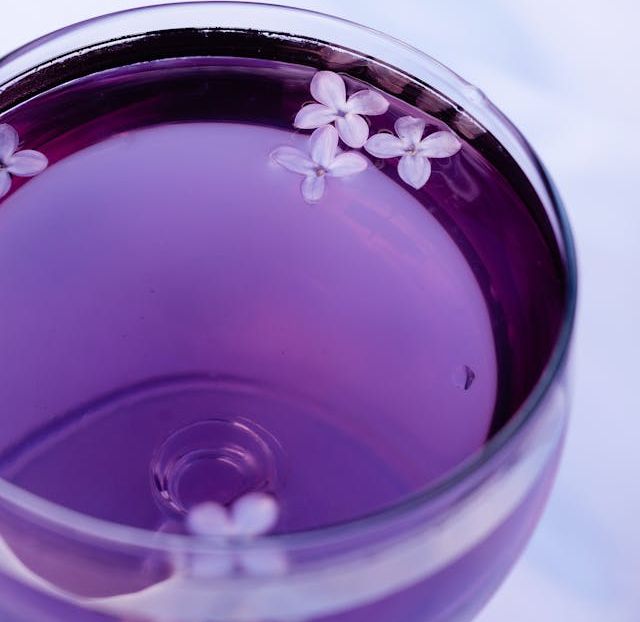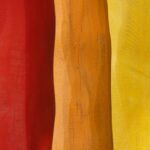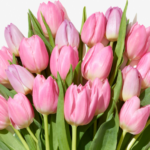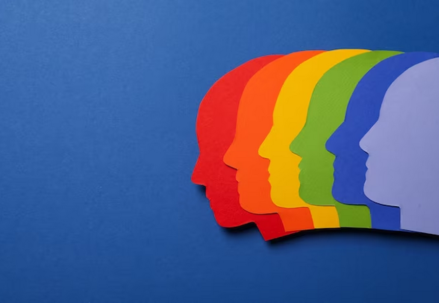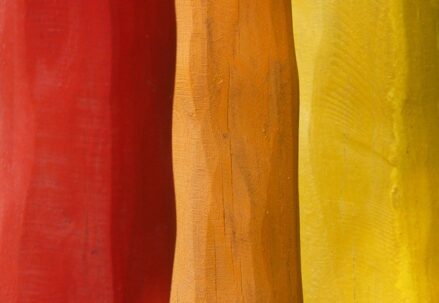As a vast and profound construct, color theory provides an indispensable framework which artists and designers leverage to proficiently navigate the intricate world of color in their creative endeavors. This dynamic assemblage of rules and guidelines acts not just as a theoretical tool but also offers practical insights into the complex interplay amongst colors. For example, queries akin to “What color is counteractive to purple?” can be swiftly addressed by employing the color wheel; this is a fundamental component within the context of color theory.
The color wheel epitomizes an aesthetically satisfying arrangement of hues encircling its circular diagram, thereby depicting relationships amongst primary, secondary, tertiary colors and beyond. Examining and decoding this visual representation enables one to deduce that yellow stands as the antithesis to purple on this colorful spectrum. Such comprehension about opposing colors unravels an entirely novel universe teeming with possibilities for imaginative minds – artists and designers alike; providing them with a potent instrument for crafting visually appealing harmonious palettes. Thus, mastering such principles embedded in color theory emerges as an imperative skillset within visual arts.
The Meaning of Opposite Colors
In the broad and perplexing realm of chromatic theory, grasping the notion of opposing hues – known as complementary colors – holds critical importance to an artist’s array of paints. Of particular intrigue is a question that sparkles with curiosity: which shade dares to stand against purple? The answer erupts in a vivid burst from its vibrant counterpart – yellow. Each firmly planted at diametrically opposed ends of the color spectrum, their simultaneous presence ignites an electrifying visual tension.
The connection between purple and yellow extends beyond mere optical contrast; it serves as a symbolic conversation between divergent moods and emotions these colors evoke. Purple, born from the fiery passion of red meeting serene blue’s tranquility, encapsulates enigma, creativity, depth in profound bursts. Yellow meanwhile radiates like sunlight itself – emblematic of joyfulness, vitality and optimism in all its effervescent glory. This captivating polarization imbues their contrast with magnetic allure while providing an intriguing dive into both the scientific study and expressive artistry inherent within colors.
- The interplay of purple and yellow, as opposing hues on the color spectrum, creates a striking visual impact that artists can harness to evoke specific emotions or moods. This contrast is not merely aesthetic; it taps into deep-rooted psychological associations we hold with these colors.
- Purple, as a blend of passionate red and tranquil blue, often symbolizes mystery, creativity, and depth. It’s associated with luxury and royalty due to its historical rarity and costliness.
- Yellow represents joyfulness, vitality, optimism – akin to the warmth of sunlight. Its brightness can stimulate mental activity while also promoting cheerfulness.
- The juxtaposition between purple’s enigmatic allure and yellow’s effervescent spirit provides an intriguing case study for both scientific research in color psychology and artistic exploration in visual composition.
- Scientifically speaking:
- Studies have shown that different colors can influence our mood or behavior. For instance: warm tones like yellow are stimulating while cool tones like purple tend to be calming.
- Research suggests that contrasting colors create visual tension which may draw attention or provoke intrigue more effectively than harmonious color schemes.
- From an artist’s perspective:
- In graphic design specifically: designers utilize this principle of complementary colors (like purple & yellow) to highlight important elements within their compositions.
- Artists use complementary colors strategically in their work for balance because they provide high contrast thus making each other stand out when placed side by side
Utilizing opposite or complementary colors such as purple-yellow pairing is not just about creating visually appealing designs but also about stirring emotional responses from viewers through symbolic associations inherent within these hues. Whether you’re an artist seeking inspiration for your next masterpiece or simply someone curious about the fascinating world of chromatic theory – understanding how contrasting shades interact could open up new avenues for creative expression or deepen your appreciation towards artistry imbued in everyday life around us.
The Color Wheel: A Basic Guide

In the grand scheme of color theory exploration, unravelling the mysteries of the color wheel stands paramount. This circular spectrum presents a methodical, systematic visual display of colors hinging on their chromatic relationship. Birthed from Sir Isaac Newton’s imaginative mind and his creation – ‘the color circle’, this indispensable tool is crafted to provide an orderly arrangement encompassing both primary hues (red, blue, and yellow) and secondary ones birthed by blending these primary shades.
Venturing further into the labyrinthine intricacies of the color wheel unveils intriguing concepts like complementary or “antithetical” colors – pairs that negate each other when merged. This fascinating occurrence results in a grayscale shade upon fusion, generating a stark visual discord when positioned adjacently. A noteworthy illustration would be purple’s inverse counterpart – yellow. Such relationships have struck chords with artists and designers alike over centuries, empowering them to wield informed decisions regarding color harmonies within their creative endeavors.
How Complementary Colors Work
To navigate the intricate framework of color theory, one must grapple with the enigma of complementary colors. They are hues that sit diametrically opposite each other on the chromatic wheel. When juxtaposed, their individual brilliance intensifies remarkably, igniting an intriguing dance of contrast and vibrancy. This stark opposition is aptly christened “simultaneous contrast”, a phenomenon that shapes visual perception and amplifies aesthetic charm.
The doctrine of complementary colors wields significant sway over art, design, and visual dialogue. These colors achieve equilibrium within the color spectrum: when amalgamated they have potential to birth a grayscale hue or neutralize each other into producing a muted yet complex rendition of original shades. Assembled together they create striking colorful tapestry which often grace marketing materials and media outlets for their uncanny ability to command attention. Complementary colors invigorate images with depth, generate impact and direct viewers’ gaze towards salient features.
Deciphering the Purple Hue: Its Significance and Impact
In the labyrinthine domain of chromatic theory, purple is a pigment teeming with complexity and intrigue. Melding the blazing vigor of red with the soothing serenity of blue, it embodies a binary nature seldom witnessed in other color spectrums. Purple frequently finds itself entwined with connotations of regality and opulence due to its infrequent appearances in nature, thus making it an extravagant dye in ancient societies.
Plunging deeper into its essence, purple takes on a momentous role within psychology and symbolism. Entangled with creativity, imagination, and spiritual enlightenment – it fosters introspective journeys and abstract cogitations. Furthermore, as a hue tethered to wisdom’s depth, dignity’s stature, independence’s strength – purple’s sway leaves an enduring impression on individual consciousnesses along with collective perceptions.
Exploring Yellow: The Counterpart of Purple
In the realm of colors, yellow often stands as a beacon of energy, cognition, and vivacity. Its symbolism is singularly unique amongst various cultures. As the most radiant hue in the color spectrum, yellow projects an ambiance suffused with positivity and warmth. It engages with the left or logical hemisphere of our brains – sparking mental agility while nurturing sentiments of joyfulness. Comparable to the sun’s splendorous luminosity, yellow epitomizes creativity, resolve and optimism.
When one contemplates upon juxtaposing yellow alongside purple – its complementary counterpart on the color wheel – an elaborate interplay comes into light. In stark divergence from purple’s soothing ambiguity; resplendent in vivacity – that is what truly characterises yellow. When brought together within artistic compositions these two hues cultivate a startling contrast that seizes attention visually. This difference not only accentuates their individual characteristics but also deepens them: making purple appear even more intense when set against effervescent yellow; conversely rendering yellow even more vibrant against a backdrop bathed in shades of purple.
Analyzing Purple and Yellow: An Artistic Perspective
In the artistic sphere, the collaboration between hues of purple and yellow is astonishingly potent and metamorphic. Occupying opposing seats on the color wheel’s grand circle, they are hailed as complementary companions. These two shades possess an enthralling ability to amplify each other’s brilliance when brought together in close proximity. They carve out a striking juxtaposition that bravely steers the observer’s attention within an artwork, constructing remarkable depth and focal point. Their harmony is not merely delineated by their opposite dispositions; indeed, it originates from their unique synergy creating a visual extravaganza that invigorates the spectator’s sensory experience.
Moreover, these diametrically opposed colors boast an expansive historical narrative coupled with deep psychological resonance. Yellow – symbolizing sunlight’s warmth wrapped in happiness – has the power to infuse optimism and rejuvenation into any piece of art. Conversely, purple – fervent and enigmatic due to its association with regality and spirituality – introduces elements of mystery and solemnity into artworks. When artists wield these two hues artistically in tandem they spark both ends of emotional continuum rendering their creation visually arresting while stirring emotional undercurrents too.
FAQs
The intriguing concept known as color theory offers a theoretical framework that artists and designers employ to comprehend and manipulate the connections between colors. It holds tremendous importance, for it aids in crafting an aesthetically pleasing visual experience, transmitting emotions, garnering attention, or even swaying decisions.
The term ‘opposite colors’, alternatively termed as complementary colors, is used to describe hues that reside directly across each other on the chromatic circle. Their pairing results in a lively contrast enriching an artwork’s visual charm.
A color wheel presents itself as a circular chart visually illustrating how different shades relate to each other. It features primary hues (red, blue, yellow), secondary ones (born from blending primary tones) along with tertiary ones (generated by merging primary and secondary shades).
Complementary hues generate dramatic contrasts when amalgamated together making each hue appear more radiant. Artists frequently utilize this phenomenon to guide viewer’s gaze towards significant components or trigger specific emotional reactions.
Purple denotes balance being born out of red and blue fusion. Linked traditionally with wealth, royalty & power due its scarcity in nature coupled with high production costs associated historically with it; it can arouse feelings of enigma, spiritualism & creativity.
The sunny shade we call yellow – one among three main pigments – typically evokes joyousness warmth & vitality attributed largely due its luminosity & prominence; symbolizing positivity clarity enlightenment while denoting caution/cowardice under certain conditions/excessive usage.
As color wheel opposites, when the regal purple meets cheery yellow they create an electrifying contrast. This dynamic duo can be used to spotlight principal elements in artwork or stir powerful emotional reactions. Further, the clash between warm yellow & cool purple could either denote conflict or harmony depending on context.
